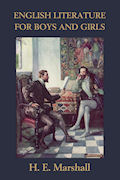Ambleside Online has influenced our family in many ways, not the least by introducing us to great books. One that we’ve been using for many years is English Literature for Boys and Girls by H.E. Marshall, written in 1909. We are blessed to have a century-old copy for our children, complete with roughly cut pages and sturdy binding.
In 85 delightful chapters, H.E. Marshall traces English literature from the ancient Irish legend “The Cattle Raid of Cooley” to Tennyson. She includes excerpts of stories and poems, summaries of larger works, and many interesting biographical and historical tidbits. She expresses strong opinions about authors and works, and occasionally makes some disparaging remarks about various branches of the Christian faith.
English Literature for Boys and Girls is a solid book, full of information. Since history and literature are so closely entwined, it includes numerous references to kings and queens, to the changes in the English language, and to cultural innovations such as the rise of newspapers.
As a random sample, in chapters LVII and LVIII Marshall discusses Milton, “a cold and lonely man.” She begins with his childhood, quotes 14 lines of On his being arrived to the age of twenty-three, and continues, discussing his life and his poetry as well as venturing into the conflict between Puritans and Royalists. While Milton became more embroiled in politics, his personal life suffered. He lost his sight, his wife died, “his children ran wild,” his second wife died, and he began to write Paradise Lost. Several pages and excerpts later, Cromwell died, Milton married again, and the blind poet wrote Samson Agonistes, the tragic story of Samson in his blindness.
Don’t let the “Boys and Girls” part of the title fool you; this is not a childish book at all and shows just how far educational standards have slipped in the last 100 years. In fact, Ambleside Online, a rigorous Charlotte Mason curriculum with classical leanings, recommends English Literature for grades 7 to 10. The subject matter is not too easy for today’s teens, but occasionally Marshall’s intended audience causes her to write in a somewhat patronizing way. As I’ve come to expect from old authors, the English would be considered advanced today even though it was written for boys and girls, but no well-read modern teen would have difficulty with it.
All of our teens have read significant portions of this book over the course of several years. Each week they studied a chapter or two and I would ask for either an oral or a written narration. They have become familiar with early English literature and I am amazed at the history they know.
English Literature for Boys and Girls is a brilliant work, ideal for introducing modern teens to both literature and history. It is fascinating, lively, thorough, and eminently suitable for young people since no ‘adult’ topics are included as is often done nowadays. Of course, modern literature is not covered (and Jane Austen was left out, a serious flaw in my opinion). Even so it is an excellent book for homeschooling families, especially those interested in classical education or Charlotte Mason’s methods.
It is available online at Project Gutenberg and The Baldwin Project. You can also buy a book here.
–Written by Annie Kate, a Christian homeschooling mom of five, who reviews and blogs at Tea Time with Annie Kate. You can read her other Curriculum Choice reviews here.
Disclosure: As usual, I am not paid for my reviews and my opinions are my own.


Thank you for reminding me about this book. I have a copy on CD for UK home educators (The Mother’s Companion). Whilst I have used other material on the CD, “English literature for boys and girls” isn’t something that we have yet used.